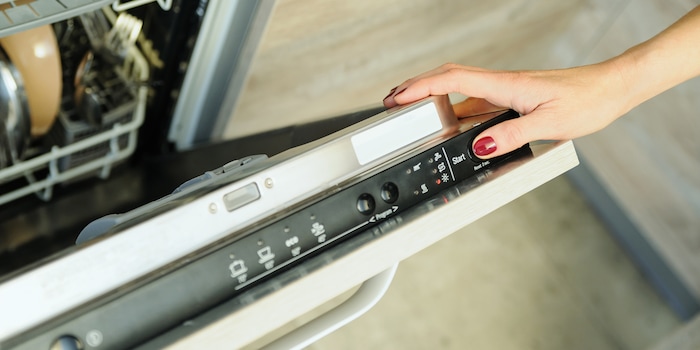

Find the right dishwasher for your place setting
Do you need a new dishwasher but don't know which one is best for you? This little guide will help you make the right choice so that your dishes are cleaned under optimum conditions.
It has long been known that dishwashers use less water than washing your dishes by hand. There are three types of dishwasher, each of which is standardised differently. When purchasing, please note that the decoration front is not included with our products.
Different types of dishwashers
Fully integrated models
Fully integrated models are installed in kitchen units or fitted kitchens. The decor is usually the same front as the cabinet doors. This means the dishwasher disappears discreetly and is not visible from the outside. The controls are concealed on the top edge of the door. This preserves the overall appearance of the kitchen. However, the placement of the elements means you cannot see the remaining running time.
An overview of all fully integrated models
Integratable models
Integrated dishwashers are also built into the kitchen. The difference to fully integrated appliances lies in the visible controls on the front of the appliance. This means that the buttons and other controls are visible even when the appliance is closed. Undercounter dishwashers can be pushed flush under the worktop. Floor-standing appliances are installed separately and can therefore be positioned flexibly.
All integrable models at a glance
Highly integrable models
Thanks to baskets and shelves, loading and unloading is more ergonomic than it used to be, but for many people bending down is a strain on the back. Thanks to special fastening devices, built-in models can also be installed at a height of 50 cm above the floor.
All built-in models at a glance
Free-standing models
Freestanding dishwashers can be positioned anywhere in the kitchen and are independent of the kitchen design. These models do not require any special built-in niches. These models are therefore flexible in their choice of location. Free-standing models are often cheaper than built-in dishwashers. The less attractive appearance is often perceived as a disadvantage, as the appliances are often white or stainless steel-coloured and do not fit in everywhere.
An overview of all freestanding models
Mass deck
When buying a dishwasher, you will often come across the word "measuring deck". This is a unit of measurement used to define the load capacity of the dishwasher. This is done according to a standard. A standard load comprises the following units: A soup plate, dinner plate, dessert plate, saucer, cup, drinking glass, fork, knife, tablespoon, teaspoon and a dessert spoon.
The practical thing about this information is that you can see at a glance whether the machine is big enough for your household. There are various empirical values that can be used to determine how many place settings per person should be expected.
- 8-10 place settings = 1-2 people
- 12-14 place settings = 3-4 people
- 15+ place settings = 5 and more people
Dishwashers with a capacity of 12-14 place settings are usually standard-sized appliances.
Einbau Geschirrspüler bis 10 Massgedecke
Einbau Geschirrspüler 10–14 Massgedecke
Einbau Geschirrspüler >15 Massgedecke
Free-standing dishwashers up to 10 place settings
Free-standing dishwashers 11-14 place settings
Free-standing dishwashers >15 place settings
The right size: European and Swiss standards
There are European and Swiss standards for dishwashers. This means that you will come across different sizes when looking for a dishwasher. The Swiss standard is called "CH-Norm 55 cm", which simply means that the appliances are 55 cm wide. This also applies to the "Euro Norm 60 or 45". Accordingly, the appliances are 60 and 45 cm wide. This information is important for built-in dishwashers so that the appliance fits into the intended recess.
Built-in dishwasher according to CH standard 55 cm
Fitted dishwasher according to EU standard 45 cm
Einbau Geschirrspüler nach EU-Norm 60 cm
Water-saving appliances
A dishwasher uses less water per wash cycle than washing up by hand. With very economical appliances, around 10 litres are sufficient in the economy programme. The appliances only change the water during washing once a certain level of soiling has been reached.
Energy efficiency
When buying a dishwasher, you should take a look at the energy efficiency logo. Here you can easily see the energy consumption, cleaning and drying capacity.
The energy efficiency logo and its explanation

- Manufacturer (brand)
- Model name (exact model name)
- Energy efficiency class from A+++ (best) to D (worst)
- Energy consumption in kWh per year, determined using a standardised method
- Water consumption in litres/year, also determined using a standardised method.
- Dry efficiency class: In this case, A is the best rating, G the worst rating.
- Dimensioned place settings: Maximum load quantity, calculated on the basis of so-called dimensioned place settings.
- Loudness: Noise level during washing in dB (decibels).
All energy-saving built-in dishwashers
All energy-saving freestanding dishwashers
Friends, family, cats and good wine are my lifeblood.

